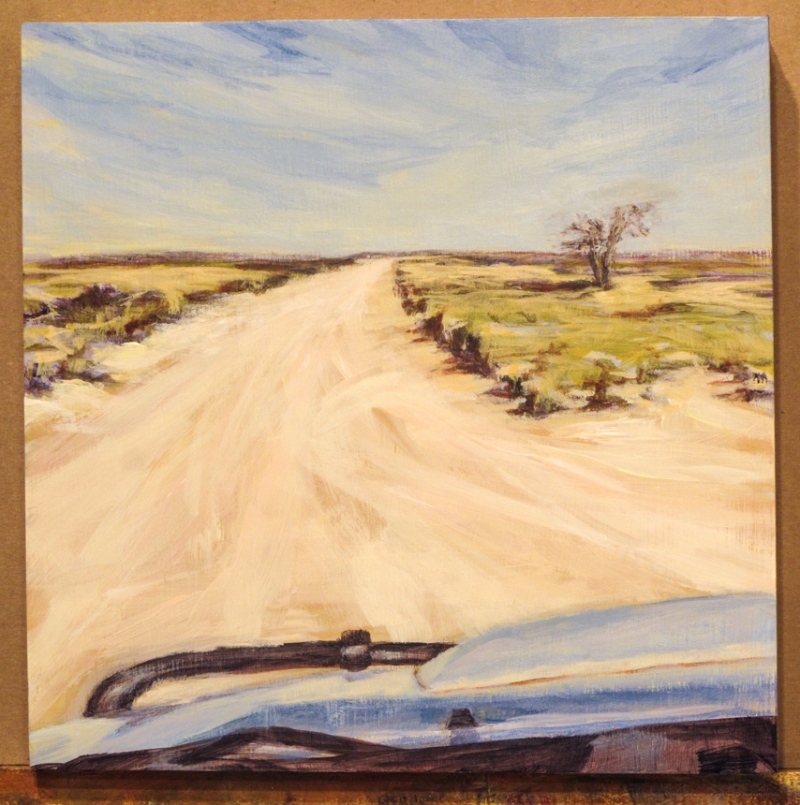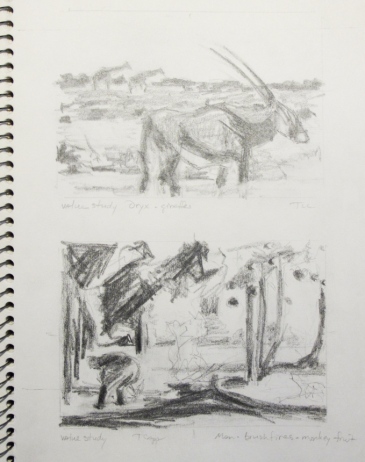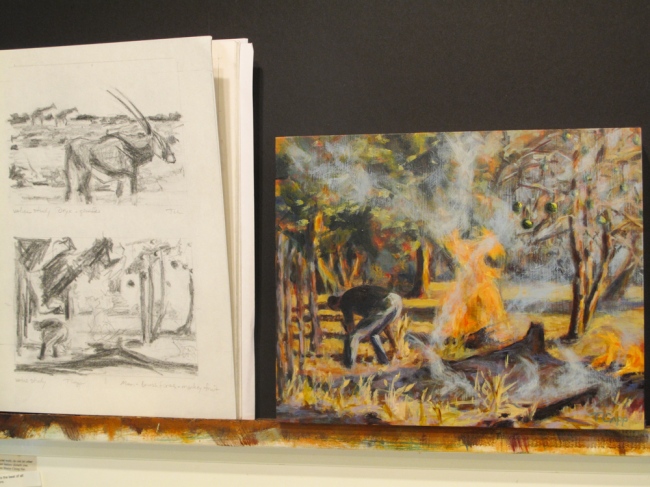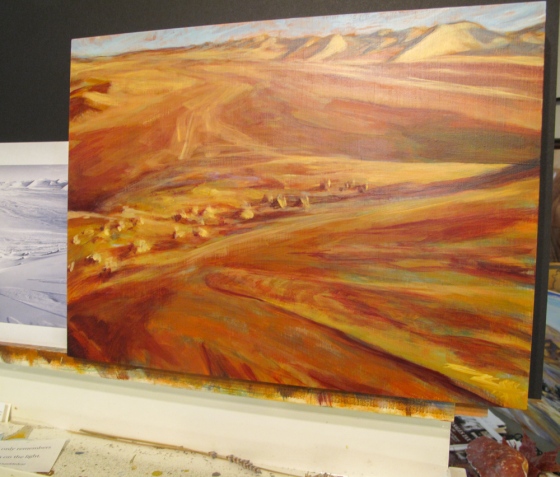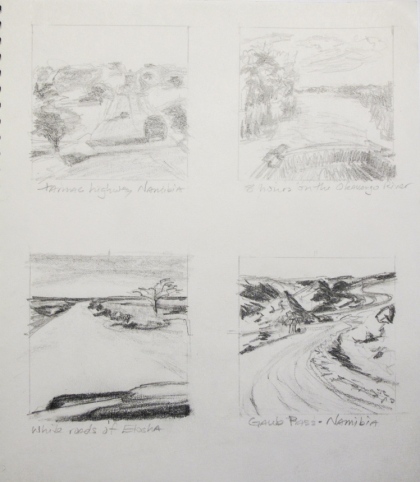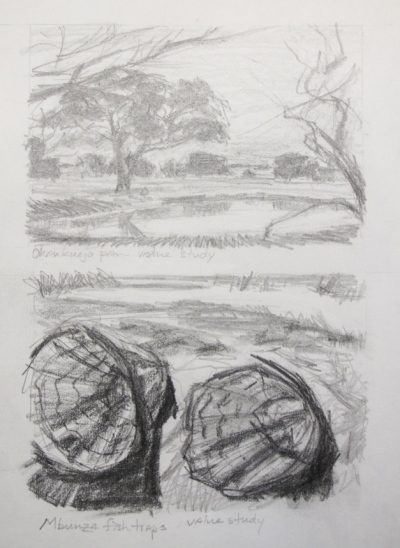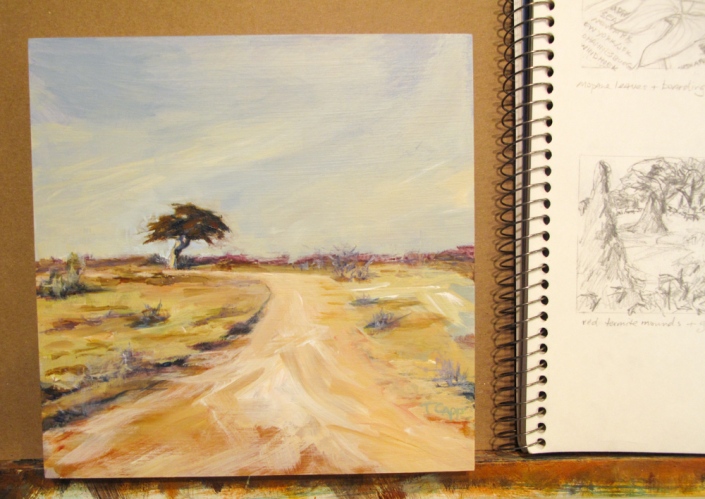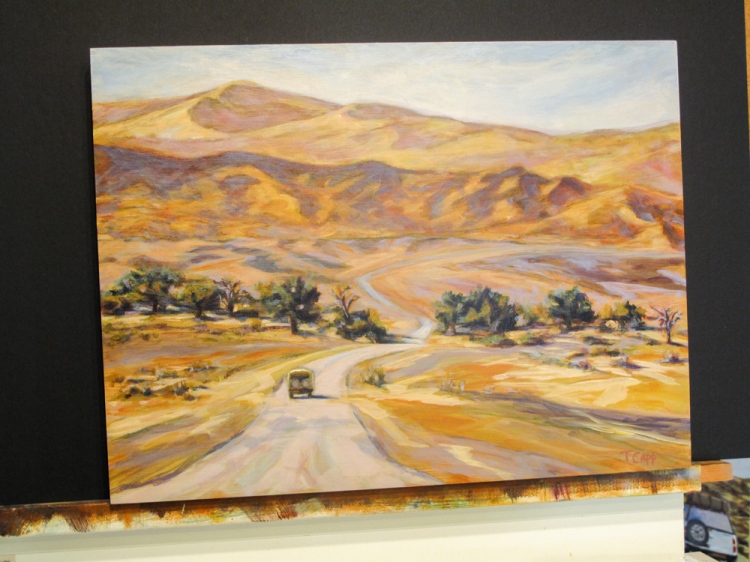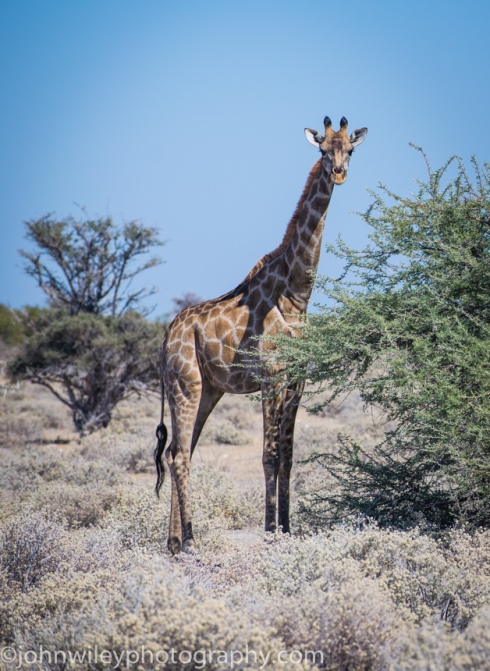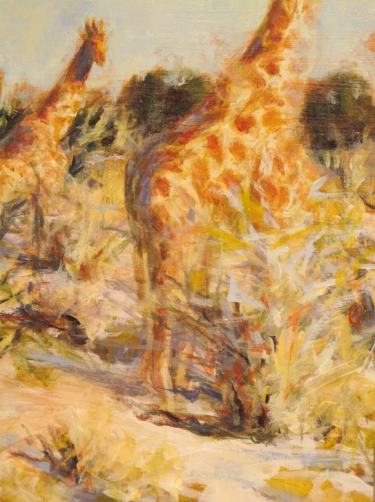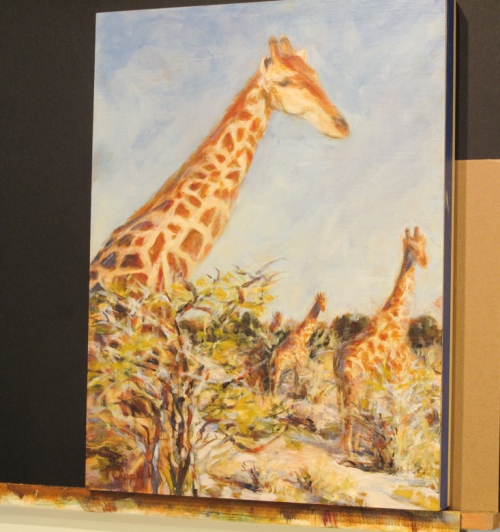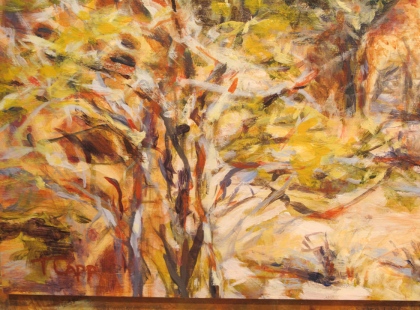
On our way – a bit of tarmac and another dusty road, after leaving Sarasungu Camp. Questioning where I was – again – as brilliant sunlight spread across northern Namibia and the Kavango River. Turning off of the main dirt road, we wound our way past yellow millet and sorghum crops…goats and kraals (family villages). Seeing a cluster of thatch huts ahead, we slowed and parked…stepped out of our 4×4 baakie, into bright sand, dappled with shadows from thick groves of acacia trees.
Only Cecil, my brother-in-law knew some of what was in store for us. He has forged a friendship with Zebron, one of the founders of the Mbunza Living Museum. It is one of four Living Museums that have been set up in Namibia. Zebron greeted us with his broad, bright smile and deep voice. At his invitation, we followed him, and all five of us tried to squeeze into the tiny reception hut – dark and shady, with stripes of sunlight marking the floor of sand.

Zebron in the reception hut
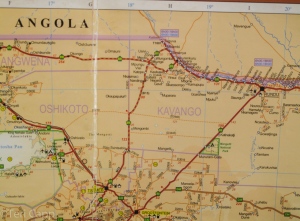
Northeast border of Namibia – Kavango region
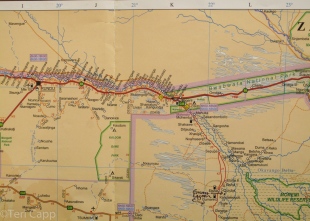
Continuing along the northeast border of Namibia

Teri’s sketch of Mbunza hut or rondoval
The Mbunza are one of five main Kavango clans and they are one of a handful of tribes in Namibia who have set up a Living Museum. It is an entrepreneurial endeavor backed by funding from the Namibian Government’s Cultural Affairs office and private funding. Cecil’s friendship with Zebron was born of a film project that happened over the past two years. Cecil, a filmmaker and producer, was working with another artist to gently and beautifully tell some of the story of the traditions and customs of the Mbunza. Their film is titled, “The Mbunza of the Kavango.”
As we stood in the reception hut with Zebron, we had choices to make. An hour or two walk and talk? A craft-making workshop? In the end we decided to sign up for the craft-making…a hands on experience. We paid our fees and waited for our instructions. My sister, Kristin, and my daughter and I chose to make baskets with some of the Mbunza women. John and Cecil chose to make an arrowhead with blacksmith tools over a fire. What we thought was to be a couple of hours turned into an amazing four-plus hours with an entire walking tour of the kraal (village) and oral histories of their customs and tools, objects and work.
The actors who we met, in the Living Museum, shared with generosity – their lives – their history, and the crossover into their “now. The concept of a “living museum” is so marvelous and relevant, with storytelling at its core. The stories were the mingling of the present with the past ~ trying to find a balance ~ a place in their minds and hearts to carry on ~ push forward with parts of their traditional culture ~ to find the place where the stories help them understand their place in the modern world. Most of the group of twelve to fifteen “actors” have day jobs, if you will ~ especially the young; working as laborers on farms, in mines and in urban centers or towns, offices and stores. Their energy spent participating in the Living Museum was part-time work ~ an avocation, that added value and meaning to their lives as well as some financial reward.

Mbunza man preparing blacksmithing fire. Photo by Cecil Moller
The idea of the Living Museum could be perceived as contrived, but as each hour went by ~ exchanging gestures, glances , smiles and shared questions about each other, I realized how life-affirming the experience was ~ for all of us. There was a genuineness and sincerity about the Mbunza ~ silliness and humor ~ in their conversations with each of us. I saw camaraderie and respect between our group of Mbunza guides…an authenticity; they enjoyed each other. Again life-affirming and real. They were living in the story of their own cultural inheritance.

Still life with a womans’s foot as she sorted mangetti nuts

“Mahangu” or millet being sifted before grinding
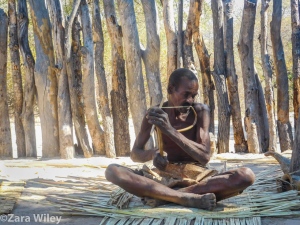
Mbunza man playing the instrument he made for hunting springbok
An introduction to another world…what was this place?..this story?…this place of animal skins, softened by hand – every part used – nothing wasted. Fishing from the Kavango River and the lakes, with their handsome woven-reed traps. This story of handmade instruments…a bowl shaped piece of wood – with sinew fastened to make a humming sound when strummed to attract the springbok when the hunter used it in the bush.
The depth to which their “form followed function” was compelling. Big gourds filled with goat or cows milk…hung from a small wooden rack…pushed by hand to rock back and forth while the person sang and churned the milk into butter. Sleeping mats were made of the reeds from the river banks…flattened and woven. Baskets were made for storing and holding food and other items. The mats were woven by the Mbunza men…to show they could work and provide for a family…that they had learned and had not been lazy when they were young! Basket weaving was done by the women of the tribe to demonstrate their ability to cook for their families.
Zebron then shared a lovely story with us about a daily ritual of the Mbunza…
At the end of the day, family groups would circle around the gathering fire. It was kept burning 24 hours – never let to burn out. Family and tribal members gather to tell stories from the day and how they connect to the past. A very grounding and centering act of connection with the people who mean the most in their lives. It made me think of our daily ritual at home…holding hands before we eat and saying something we are each grateful for that day. It’s calming and helps us look forward and to feel like someone has our backs.

Zebron telling the story of the days-end “sharing” shrine. It was built of bones from their supper and the men’s bows were laid against each other to bring good luck for the next day’s hunting.
Craft-making was happening! ~ We hunkered over the long strands of reeds which we were supposed to persuade into the shape of a basket. Angelica (Pandu), my teacher, made it look easy as she quickly poked a hole with a big nail, pushed the sharp end of the grass through, and wrapped the grasses into patterns and coils to end with the desired shape. Kristin, Zara and I each had a teacher and we sat together, working, laughing and talking for over an hour.

Teri, Zara and Kristin intently working on our baskets

beautiful shapes, beautiful hands, real people…well seen by John and his camera

group shot of the basket makers and our wise teachers
Meanwhile, John and Cecil worked outside of the kraal fence, bent over a small fire with a piece of iron to heat and forge into an arrowhead. …plink, plink…plink, plink, the ringing of iron on iron.

John’s arrowhead in the making!
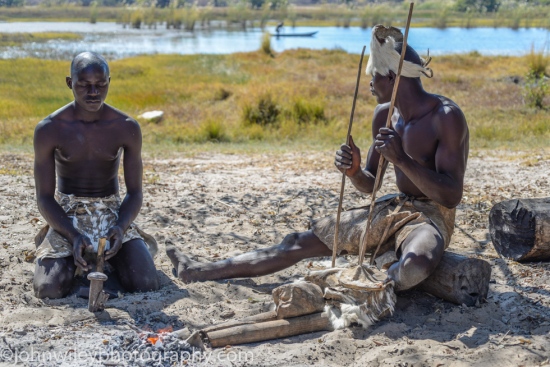
The amazing design of the hand-worked bellows.

Mbunza man blacksmithing

In the heat of the mid-day sun; arrowhead making crew
Again, it was the gestures, small conversations in these intimate groups that allowed us to laugh together, ask questions, make mistakes and know each other – even if just a little.
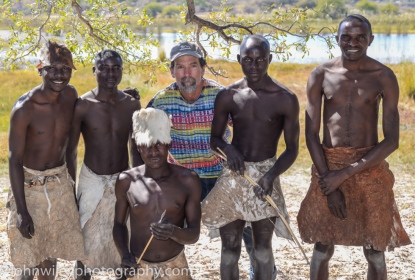
Arrowhead and friendship forged!
We photographed and I sketched as much as possible, while we moved around the village that day…absorbing this place.
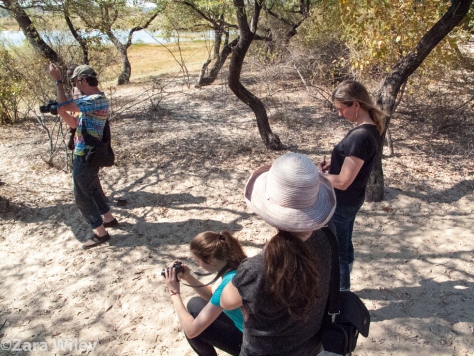
Busy moments…observing, listening, recording our time together…to remember. Photo by Cecil Moller
Later, we were drawn to the marshy land by the river and Lake Samsitu, where the Mbunza women demonstrated the fish traps. (I loved the sculptural shapes of the traps) John had to try his hand at using one! Then he smiled, and asked, and joked his way into a makoro (dugout canoe) ride too. Much laughter ensued…all around!
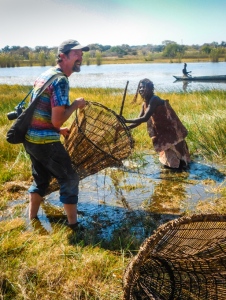
John fishing in the Kavango delta

Arrowhead and friendship forged!

Makoro, Mbunza paddler and John…with his camera

John’s perspective in the makoro.
Another highlight as we hung around down by the lake, was finding a slow-moving chameleon…a rather large one. We picked it up and photographed it…but the Mbunza people would not touch it! Some kind of superstition. A belief in Malawi is that they are enemies reincarnated. We were told some believe the chameleons to be venomous. We didn’t know why the Namibians shied away from them.

The chameleon and Cecil

Chameleon in John’s hands
Last, but not least… we were invited to move…to “please sit” – under the trees…we leaned back against a primitive log rail and waited…as the Mbunza gathered. The women all formed a line on one side and the men on another, forming an L-shape. The women began to sing and clap and the men who weren’t drumming moved into the center and started to dance. One woman at a time would step out and dance in the center too.
Then a whirl of dust, a rhythmic pattern of beats on drums, louder…and stamping feet with ankle rattles and reed skirts. A song was rising. They held us with the pulse – the – circle – swirl – stamp – in the shadows of the acacias. Rolling, shrill, calls and ululation (a howl or wailing sound made as an expression of strong emotion) and harmonic singing – big smiles and sweat and dancing…until it was time to say goodbye. Continuing on the road…continuing with our lives.

Mbunza dancing
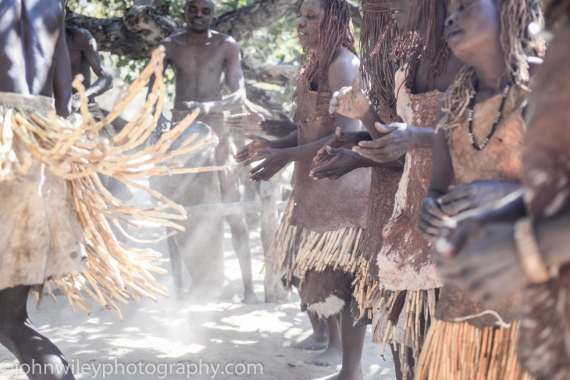
Faster, faster…

Zebron on the drums
There is always more to the story ~ especially an ongoing story ~ where the characters are alive, creating a concrete coexistence between their modern lives and their history. We landed in one part of their universe…a blip on their timeline…but they were so willing to share.
Again, as I pore over the images of our journey around Namibia, I’m reminded of the value of travel to a different place. The true, real-time interactions explode stereotypes. They open up my mind to creative thinking. The touch of a hand with someone who lives every day – 9,000 miles and another continent away, leaves an awareness and openness in my soul that never goes away.
Take your kids ~ travel ~ take yourself.
My compliments to my fellow-traveler-photographers for their work included in this blog post! JohnWiley, Zara Wiley and Cecil Moller
Questions? Comments? Interest in my work? E-mail or call. cappwiley@gmail.com Tel: 206.329.4750
Follow me on Facebook
©Teri Capp-all rights reserved
